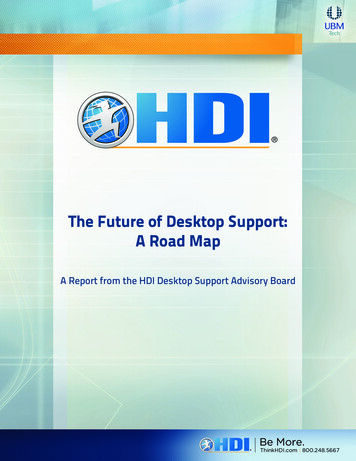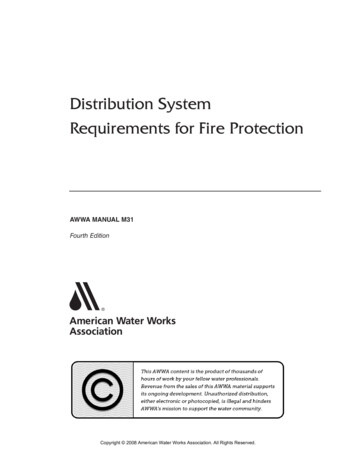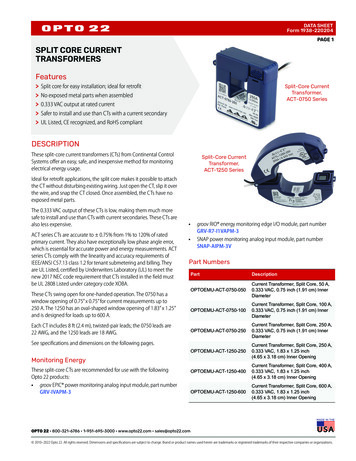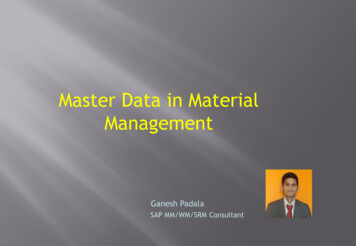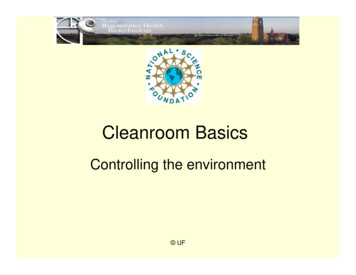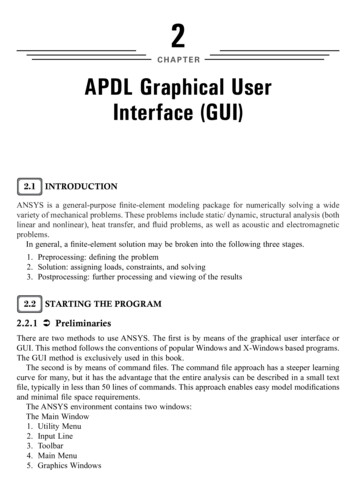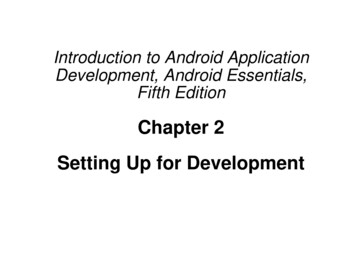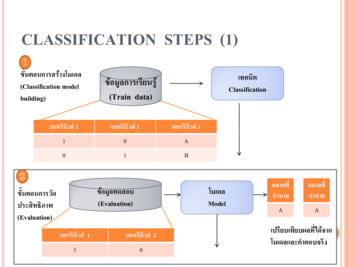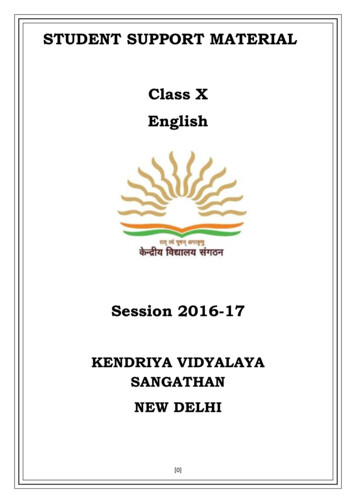
Transcription
STUDENT SUPPORT MATERIALClass XEnglishSession 2016-17KENDRIYA VIDYALAYASANGATHANNEW DELHI[0]
STUDENT SUPPORT MATERIALADVISORS Shri Santosh Kumar Mall, IAS, Commissioner, KVS (HQ), New DelhiShri U.N. Khaware, Addl. Commissioner (Academics), KVS (HQ)CO-ORDINATION TEAM AT KVS (HQ) Dr. V. Vijayalakshmi, Joint Commissioner (Acad), KVS (HQ)Mr. P.V. Sai Ranga Rao, Deputy Commissioner (Acad), KVS (HQ)Ms. Aprajita, AEO (Acad), KVS (HQ)CONTENT TEAM Mr. D. T. Sudharsan Rao, Deputy Commissioner, KVS VaranasiRegionMr. Ashwini Kumar, KV New Cantt, Allahabad (1st Shift)Mr. Anupam Kumar, KV New Cantt, Allahabad (1st Shift)Mr. Manutosh Dutta, KV NTPC ShaktinagarMr. Ashutosh Kumar Singh, KV Old Cantt. AllahabadREVIEW TEAM Ms. K. Tulsi Sharma, TGT (Eng), KV AFS Rajokri.Ms. Usha Sharma, TGT (Eng), KV Pushp Vihar[1]
CONTENTTOPICSPages1. SYLLABUS3-42. BLUE PRINT of question paper and TERM WISE SPLIT UP5-63. SECTION A : Reading Passages7 -164. SECTION B – WRITING AND GRAMMARi. Writing – Letter Writing17-19ii. Writing – Article Writing20-23iii. Writing – Story Writing24-255. SECTION B – WRITING AND GRAMMARi. GRAMMAR26-466. SECTION C – LITERATURE AND LONG READING TEXTi. Literature – FICTION47-65ii. Literature – POETRY66-91iii. Literature – DRAMA92-1077. SECTION C - LITERATURE AND LONG READING TEXTi. Long Reading Text (NOVEL)The Story of my Life[2]108-114
ENGLISH COMMUNICATIVE (Code No. 101)SYLLABUSSummative Assessment (2016-17)CLASS – XSECTION WISE WEIGHTAGE IN ENGLISH COMMUNICATIVESectionTotal Weightage90AReading Skills20BWriting Skills with Grammar25CLiterature Textbook and Extended Reading Text25DAssessment of Speaking and Listening (ASL)20TOTAL90Note:It is a division of marks assigned to all the four skills of language. The distribution ofmarks for Formative Assessments carrying 40% weightage may be done by the schoolsthemselves. A variety of activities to assess all the skills of language may be used forFormative Assessments. The Summative Assessment Question Papers, if developed bythe schools themselves, may be for 70 marks to which 20 marks may be added forAssessment of Speaking and Listening skills making the paper of 90 marks. The onethird of the 90 marks i.e. 30 should be added each in both Summative Assessments.Assessment of Speaking and Listening skills (ASL) will be done formally at the term endexamination in Summative – II. Schools can conduct ASL for Summative – I themselvesas per the guidelines provided by the CBSE. However, assessment of these skills mayalso be done under the Formative activities spread over two terms.There will be one written paper of English at the end of each term carrying 70marks. The time limit will be three hours.Prescribed Books: Published by CBSE, New DelhiINTERACT IN ENGLISH SERIES1. Main Course Book (Revised Edition)2. Workbook (Revised Edition)3. Literature Reader (Revised Edition)EXTENDED READING TEXTS:NOVEL: The Story of My Life – 1903 by Helen Keller (unabridged edition)SECTION A: READING20 MarksQs 1-2. This section will have two unseen passages of a total length of 700-750 words.The arrangement within the reading section is as follows:Q.1: A Factual passage 300-350 words with eight very short answer type questions.8 marks[3]
Q. 2: A Discursive passage of 350-400 words with four short answer type questions totest inference, evaluation and analysis and four MCQs to test vocabulary.12 marksSECTION B: WRITING & GRAMMAR25 MarksQ. 3: Letter to the Editor /article in about 100-120 words will make use of any visual /verbal stimulus and the question will be thematically based on the MCB.5 marksQ.4: Writing a short story based on a given outline or cue/s in about 150-200 words.10 marksThe Grammar syllabus will include the following areas in classes IX & X.1. Tenses2. Modals (have to/had to, must, should, need, ought to and their negative forms)3. Use of passive voice4. Subject – verb concord5. Reporting(i) Commands and requests(ii) Statements(iii) Questions6. Clauses:(i) Noun clauses(ii) Adverb clauses of condition and time(iii) Relative clauses7. Determiners, and8. PrepositionsThe above items may be tested through test types as given below:Q. 5: Gap filling with one or two words to test Prepositions, Articles, Conjunctions andTenses.3 marksQ. 6: Editing or Omission4 marksQ. 7: Sentences reordering or Sentence Transformation in context.3 marksSECTION C: LITERATURE TEXTBOOK AND EXTENDED READING TEXT: 25 MarksQ. 8. One out of two extracts from prose / poetry / play for reference to context. Threevery short answer questions. One mark in each extra will be for vocabulary. Onequestion will be used for testing local and global comprehension and one questionwill be on interpretation.3 marksQ. 9. Four short answer type questions from the Literature Reader to test local andglobal comprehension of theme and ideas (30-40 words each)2x4 8 MarksQ.10. One out of two long answer type questions to assess how the values inherent inthe text have been brought out. Creativity, imagination and extrapolation beyondthe text and across the texts will be assessed. (80-100 words).4 marksQ.11. One out of two Very Long Answer Question on theme or plot involvinginterpretation, inference and character, in about 150-200 words based onprescribed novel.10 Marks[4]
BLUE PRINT OF QUESTION PAPER (SA-I & SA-II)CLASS – XEnglish Communicative 2016-17 (Code No. 101)TypologyReadingSkillsCreativeWritingSkills erstanding,decoding,analyzing,inferring, interpreting andvocabulary.Expressing an opinion,reasoning, justifying,illustrating, appropriacyof style andtone, usingappropriate formatandfluency. Applyingconventions, usingintegratedstructureswith accuracy andfluency.Recalling, ,extrapolating,illustratingand justifying etc.Extractingrelevantinformation, identifyingthecentral theme andsubthemes,understanding thewriter’smessage andwriting fluently.SAQ30-40words2marksLAQ-I LAQ-II80100100120words words45marks --010125030401-012525x1 708x2 16 1x4 4 1x5 5 2x10 2025marks marks steningSkillsVSAQ1markInteraction, reasoning,diction, articulation,clarity, pronunciationand overall fluency20Marks90MarksTOTAL[5]
ENGLISH COMMUNICATIVE TERM-WISE COURSESummative Assessment (2016-17)CLASS X (Term wise Split up)TextbooksLITERATURE READERSummative Assessment – I (Term I)Summative Assessment – II (Term II)PROSE1. Two Gentlemen of Verona1. A Shady Plot2. Mrs. Packletide’s Tiger2. PatolBabu –A Film Star3. The Letter3. Virtually TruePOETRY1. The Frog and the Nightingale1. Ozymandias2. Mirror2. The Rime of Ancient Mariner3. Not Marble, nor the Gilded Monuments3. SnakeDRAMA1. The Dear Departed1. Julius CaesarMAIN COURSE BOOK1. Health and Medicine1. Environment2. Education2. Travel and Tourism3. Science3. National IntegrationEXTENDED READING TEXT (NOVEL)The Story of My Life – 1903, Chapters 114By Helen Keller (unabridged edition)The Story of My Life – 1903 Chapters 15-23By Helen Keller (unabridged edition)WORK BOOK1.Determiners1.Comparison2.Tenses2.Avoiding Repetition3.Subject-Verb latives5.Active and Passive6.Connectors6.Reported Speech7.Conditionals7.Prepositions[6]
SECTION A: READING (20 Marks)Reading passage is the passage given in Formative & Summative exams which isrequired to be read and understood. The questions that follow need to be answered.You need to understand the passage before getting down with the questions.SKILLS TESTED: Reading for comprehension, conceptual understanding, criticalevaluation, decoding, inference, interpreting analysis and vocabulary are the skills tobe tested in Formative as well as Summative Assessments.Some tips to answer unseen passage questions:1. Read the questions first. It saves time to know what you are reading for.2. Make sure you understand the questions. Underline the key word(s) in the questionsand look in for the key words in the passage.3. Now, Read the passage. Read the passage as quickly as you can. Look for the answeras you read. When you find the answer, take notice of it.4. Use the key words from the question to locate the answer in the passage as discussed.Keep on reading. Read to the end. In this way you can be sure that your answer is thebest and complete.5. Try to get a general idea of the passage. You are not expected to know the meaning ofall the words in the passage. Your three body organs should act in collaboration –Eyes, Hand and Brain.6. After 1st reading, read the questions once again. The questions will give you the ideafrom which part the questions are asked. It will make answering the questions easilyand correctly.7. Either synonyms or antonyms will be asked from the passage. If you do not know theword, read the referred paragraph again. You will understand what the line is tryingto convey and hence there is a possibility that the meaning will become clear to youand you will be able to answer its synonym or antonym. You just have to puzzle outthe meaning. The form of word should be noticed in doing so.8. Solve previous years’ SA1/SA2 Exam papers: By solving the previous papers you can understand and identify what kind ofquestions are framed in the examination. This will provide you sufficient practicealong with building up your confidence and enable you mentally prepared for thosekinds of questions.[7]
PASSAGE No. 1 (With solutions)1. Read the following passage and answer the questions that follow:(8 Marks)SPEEDING UP INDIA’S JOURNEY BY BULLET TRAINSBy: Vijay Kumar Dutt, Indian RailwaysHigh speed in Indian Railways is at present limited to 150 KMPH. However, in manyother countries the speed of Railways is of the order of 200 KM per hour (KMPH). InFrance, Japan, Germany, China, Spain and South Korea high speed traction above 280KMPH has been introduced. India and Japan have signed a memorandum ofunderstanding (MoU) on 12th December, 2015 on cooperation and assistance in theMumbai–Ahmedabad High Speed Rail (HSR) Project referred to by many as ‘Bullet TrainProject’. Japan has offered an assistance of over Rs. 79,000 crore for the project. Theloan is for a period of 50 years with a moratorium of 15 years, at an interest rate of 0.1per cent.The project is a 508-kilometre Railway line costing a total of Rs 97,636 crore, to beimplemented in a period of seven years. It has been agreed that for the Mumbai –Ahemdabad HSR Project. Japan’s Shinkansen Technology, known for its speedsreliability and safety, will be adopted. Transfer of technology and “Make in India” will beessential part of this assistance package. Japan will also assist India in training ofpersonnel for HSR.’ The two countries have also entered into two comprehensivetechnological cooperation agreements on 11th December 2015, for modernization andupgradation of Indian railways. These agreements have been signed during the officialvisit to India of His Excellency Mr. Shinzo Abe, the Prime Minister of Japan, duringDecember 11-13, 2015.On the basis of your reading of the passage, answer the questions: (1x8 8 Marks)a) Name the countries where high speed traction above 280 KMPH has beenintroduced.b) Which project is known as “Bullet Train Project”?c) How much time and money is estimated for the Project?d) Which technology will be adopted for the Project?e) What agreements were signed during 11th December to 13th December 2015?f) What is Shinkansen Technology famous for?g) How has Japan assisted India financially for the Project?h) Find a word from the paragraph No. 2 which means ‘Necessary’.ANSWERS:a) High speed traction above 280 KMPH has been introduced in France, Japan,Germany, China, Spain and South Korea.b) The MoU signed between India and Japan on cooperation and assistance in theMumbai–Ahemdabad High Speed Rail (HSR) Project is known as “Bullet TrainProject”c) The time of seven years and an amount of about Rs 97,636 crore is estimated forthe project.d) Shinkansen Technology will be adopted for the Project.e) The agreements signed during 11th December to 13th December 2015 weremodernization and upgradation of Indian railways.[8]
f) Shinkansen Technology is famous for its speeds reliability and safety.g) Japan has offered an assistance of over Rs. 79,000 crore for the project. The loanis for a period of 50 years with a moratorium of 15 years, at an interest rate of0.1 per cent.h) The word is ‘essential’.PASSAGE NO 22. Read the following passage carefully:(8 Marks)Heartbeats get abnormal after exercising, running, or after doing some strenuous work.There is nothing to worry about. But if your heart beats at irregular pace often, it isimportant to take note of it rather than ignore it as it can be a warning sign for a heartailment called arrhythmia.A normal heartbeats 60-100 times per minute while resting, but if it starts beating tooslowly or too fast or if the heartbeat is irregular of premature, then that condition isknown as arrhythmia. People tend to avoid it as a minor issue little knowing that it canlead to a stroke, fall due to drop of BP, loss of consciousness or even result in heartfailure.In a country where people take time to press the panic button when it comes to illnessesand medical problems, it is no surprise that a number of cases of irregular heartbeats gounnoticed for a long time. Some dismiss it as just a recurring symptom of bodyweakness; others may ignore it as a side-effect of blood pressure issues. The lack ofawareness about arrhythmia means that not many people even take note of thesymptoms.When heartbeat is not too fast, it is called tachycardia. When the beats are slow, it isknown as bradycardia. An irregular heartbeat may be due to artrial fibrillation.The problem is that the symptoms are quite vague and can be associated with otherminor medical problems in India, not many people are aware that there is a heart’selectricity related disorder called arrhythmia. Often it is diagnosed when doctors arechecking a patient for something else. More often, by the time it is diagnosed, majordamage has already been caused.It is important to take seriously any abnormality in the rhythm of our heart. There aremany symptoms that can help predict arrhythmia like shortness of breath, weakness,early fatigue, palpitations, thumping in the chest, dizziness, chest pain, fainting and, ofcourse, too fast or slow heartbeats. Ignoring these symptoms is inviting a major healthtrouble.While some type of arrhythmias can be harmless, other can be life threatening as it maydisrupt the normal functioning of the heart. In some cases, it can lead to heart failuretoo. The condition is treatable with the help of implantation of a pacemaker, devices orthrough burning the points from where irregular beats originate through radiofrequency heat waves. There are a few things in medicine where a permanent cure ispossible. For certain arrhythmia this stands true with radio frequency ablation.On the basis of your reading of the passage, answer the following questions:a) What is normal heartbeat?b) What do you call the situation when the heartbeat is too slow or fast?[9]
c)d)e)f)g)h)What happens when there is drop in BP?What results due to artiral fibrillation?When is arrhythmia detected?What danger is there when dizziness or chest pain is ignored?When does heartbeat abnormally?What is bradycardia?PASSAGE No. 33. Read the following passage carefully:(8 Marks)Effective speaking depends on effective listening. It takes energy to concentrate onhearing and understanding what has been heard.Incompetent listeners fail in a numberof ways. First, they drift off and finally they react. They let their personal feelings aboutthe speaker of the subject, override the significance of the message which is being sent.What can a listener do to be more effective? The first key to effective listening is the artof concentration. If a listener positively wishes to concentrate on receiving a message,his chances of success are high. It may need determination. Some speakers are difficultto follow, either because of voice problems, or because of the form in which they send amessage. There is then a particular need for the determination of a listener toconcentrate on what is being said.Concentration is helped by alertness. Mental alertness is helped by physical alertness. Itis not simply physical fitness, but also positioning of the body, the limbs and the head.Some people also find it helpful to their concentration if they hold the head slightly toone side. One useful way for achieving this is intensive note-taking, by trying to capturethe critical headings and sub-headings the speaker is referring to.Note-taking has been recommended as an aid to the listener. It also helps the speaker. Itgives him confidence when he sees that listeners are sufficiently interested to takenotes; the patterns of eye-contact when the note-taker looks up can be very positive;and the speaker’s timing is aided – he can see when a note-taker is writing hard and canthen make effective use of pauses.On the basis of your reading of the above passage, answer the followingquestions:a)b)c)d)e)f)g)What does effective listening lead to?What is one of the hurdles that come in the way of effective listening?Why is it difficult to understand what some speakers say?How is note making useful for the speakers?What should we do in order to concentrate?What can enhance our concentration?Find a word from paragraph No. 1 which means ‘useless/unskilled’.PASSAGE No. 44. Read the following passage carefully.(8 Marks)Legends will tell you that flamingos are no ordinary visitors to Kutch. They were thehonoured guests of king Lakho and he had forbidden the hunting of flamingos, which[10]
came to Kutch from various parts of the world every year to breed. For centuries theregion has been a heaven for the migratory birds. Today, Flamingos city, is an island inthe middle of Kutch, knownto the world over as one of the biggest breeding grounds ofthe greater flamingos, is strewn with bodies of hundreds of flamingo chicks.The parents of these chicks have fled from the island due to lack of food. Zooplanktons,algae and small fish that these birds survive on, are dying due to sudden increase in thesalinity of the Rann water. One can ever see dead fish floating.Flamingos need salt-encrusted, damp mud to build nests. The place where they buildtheir nests has to be inaccessible to predatory cats and birds. It should also havesufficient food. The right mix of sweet brackish water in the Rann is crucial for theproliferation of planktons and algae that the flamingos feed on. Faced with starvationflamingos have fled from the island leaving their chicks to feed for themselves. Till datearound a thousand flamingos have died.On the basis of your reading of the passage answer the following questions inshort:(1x8 8 Marks)a.b.c.d.e.f.g.h.How did King Lakho look at the flamingos?Where is Flamingo city situated?How has Flamingo city become a mortuary today?Why is Flamingo food not available in flamingo city?What conditions are required to build the nests of flamingos?Why did the parents of the chicks flee from the island?Write the name of the fishes from the passage?Find word from the Para No. 3 which means the same as “severe suffering due tohunger”.PASSAGE No. 55. Read the following passage carefully:(8 Marks)CHESSChess is a two-player strategy board game played on a chessboard, acheckeredgameboard with 64 squares arranged in an eight-by-eight grid. Chess isplayed by millions of people worldwide, both amateurs and professionals.Each player begins the game with 16 pieces: one king, one queen, two rooks,two knights, two bishops, and eight pawns. Each of the six piecetypes moves differently. The most powerful piece is the queen and the least powerfulpiece is the pawn. The objective is to 'checkmate' the opponent's king by placing itunder an inescapable threat of capture. To this end, a player's pieces are used to attackand capture the opponent's pieces, while supporting their own. In addition tocheckmate, the game can be won by voluntary resignation by the opponent, whichtypically occurs when too much material is lost, or if checkmate appears unavoidable. Agame may also result in a draw in several ways.Chess is believed to have originated in India, some time before the 7th century, beingderived from the Indian game of Chaturanga. Chaturanga is also the likely ancestor ofthe Eastern strategy games Xiangqi, Janggi and Shogi. The pieces took on their current[11]
powers in Spain in the late 15th century; the rules were finally standardized in the 19thcentury. The first generally recognized World Chess Champion, Wilhelm Steinitz,claimed his title in 1886. Since 1948, the World Championship has been controlledby FIDE, the game's international governing body; the current World Champion is theNorwegian Magnus Carlsen. FIDE also organizes the Women's World Championship,the World Junior Championship, the World Senior Championship, the Blitz and RapidWorld Championships and the Chess Olympiad, a popular competition among teamsfrom different nations. There is also a Correspondence Chess World Championship anda World Computer Chess Championship. Online chess has opened amateur andprofessional competition to a wide and varied group of players. There are alsomany chess variants, with different rules, different pieces, and different boards.On the basis of your reading of the passage, answer the following questions:a)b)c)d)e)f)g)h)What things are required to play chess?Name the six pieces which move differently?What kind of power do the queen and the pawn have?How can king be put into checkmate?What are the other ways of winning a chess game?When did obtaining power to pieces and standardizing rules in chess take place?What is the role of FIDE?Find a word from paragraph No. 2 that is opposite to the word ‘successor’.PASSAGE No. 66. Read the following passage carefully:THE YOGIC WAY OF LIFE(8 Marks)We give undue importance to our health and the treatment of diseases. A large numberof medicines treat only the symptoms of the disease, and not the root cause. In fact, thecause of many chronic ailments is still being researched. It is here that Yoga therapycomes to our assistance. Yoga emphasizes treatment of the root cause of an ailment. Itworks in a slow, subtle and miraculous manner. Modern medicine can claim to save alife at a critical stage, but, for complete recovery and regaining of normal health, onemust believe in the efficiency of Yoga therapy.The yogic way of life includes a code of ethics, regulations, discipline and more,combined with prayer and meditation. Even a discussion on these subjects helps onerelieve mental tensions and change attitudes. Simple Asanas help to stretch and relaxthe whole body and neutralize tensions. The sincere practice of Yoga postures benefitsall levels of experience. Through continuous practice, Yoga postures can have aprofound effect on the inner dimensions of life, establishing deep calm, concentration,emotional stability and confidence. Man is a physical, mental, and spiritual being, all thethree. Other forms of physical exercises, like aerobics, assure only physical well-being.They have little to do with the development of the spiritual or astral body.On the basis of the reading of the passage given above answer the followingquestions:a) What do most of the medicines treat?b) How is yoga different from the other treatments?c) What does the yogic way of life include?[12]
d)e)f)g)h)What do ‘Simple Asanas’ help to do?How does sincere practice of yoga postures benefit us?How does yoga therapy work?Is yoga better than physical exercise? How?What does the phrase ‘Chronic ailments’ in paragraph No. 1 mean?PASSAGE No. 7(12 Marks)7. Read the following passage carefully:BE THE CHANGE YOU WANT TO SEE IN OTHERSWe have learnt from modern psychology that nobody wants to be told what to do bysomeone else. We resist when someone tries to make us do something in a new way.Yet, we persist in trying to change others.If we want others to change their ways, tellingthem to do so will have little effect unless we are living examples of that behaviour.A team of researchers went to Africa to study the behaviour of elephants. They cameacross a herd of elephants running wild, and destroying their environment.They discovered that these were all teenage male elephants. They had no adult rolemodels to learn from. The researchers arranged to have some adult elephants broughtin. In the beginning, there was no change and the teen elephants continued to run wildand fight with each other. However, after a few days the teen elephants began to settledown. Over time, they became well behaved and their wild actions subsided.On their own, the teen elephants had no role models and did not know how to behave.Once adults were introduced into their group, the teens had role models and began tobe disciplined. In the same way, as parents, we teach our children through lovingdiscipline and by setting an example. Our children do not believe in our words alone butin what they see us do. They copy our own good and bad habits because that is theexample we set. Similarly, when we are in a position to train or teach others whetherwe are teachers, parents, employers, or citizens imploring others to be conscientiouswe must first set an example ourselves. That is the only way to bring about change. If wewant to see positive change in others and in our family, neighbourhood, community,society, or country, then we need to set a good example.Source: Speaking TreeOn the basis of your reading of the passage, answer the following questions:(2x4 8 Marks)a) How can you say that people dislike to be told what to do by someone else?b) Why did the researchers arrange some adult elephants?c) How did the introduction of adult elephants change the behaviour of teenagemale elephants?d) What is the only way to bring about change?Choose the correct option out of the choices to give the meaning of the words andphrase given below:(1x4 4 Marks)i) Persist (Para-1)a) to continue or existc) to remain absentj) Settle down (Para-3)a) settlement of accounts[13]b) to shiverc) to orderb) calm down
c) Upside downk) Subsided (Para-3)a) settled downc) express angerl) Imploring (Para-4)d) downstairsb) excitedd) guideda) instructingc) speaking loudlyb) encouragingd) beggingPASSAGE No. 8(12 Marks)8. Read the following passage carefully:REMEMBERING THE FATHER OF INDIAN CONSTITUTION – Dr. B.R. AMBEDKARDr. Bhimrao Ramji Ambedkar, popularly known as BabasahebAmbedkar, is referred toas the architect of the Indian Constitution. Dr. Ambedkar was born in a communitywhich had suffered oppression for many centuries and were treated as ‘untouchables’.However, this did not prevent him from realising his dreams. The struggle he had facedin his life had only strengthened him.At a time when untouchability was the norm, it was because of the foresight of MaharajaSayaji Rao of Baroda that Dr. Ambedkar was able to enter Elphinstone College inBombay and after graduation join the Baroda State Service. Later, the Maharaja, whowas sending some students to the USA for higher studies at the Columbia University,included Dr. Ambedkar among them. Subsequently, Dr. Ambedkar moved to the UnitedKingdom and studied at the London School of Economics and was subsequentlyawarded the degree of Barrister-at-Law by Gray’s Inn.Though Dr. Ambedkar has contributed in many walks of life as a scholar, journalist,economist, activist, legal luminary, social reformer and political leader; his biggest andmost important contribution was in his role as the Chairman of the Drafting Committeeof the Constitution of India.After India’s Independence on August 15, 1947, Jawaharlal Nehru, the then PrimeMinister of India, invited Dr. Ambedkar to be a part of his Cabinet as the nation’s firstLaw Minister. He accepted the same and on August 29, 1947 Dr. Ambedkar wasappointed as the Chairman of the Drafting Committee.(Source: Employment News)On the basis of your reading of the passage, answer the following questions:(2x4 8 Marks)a)b)c)d)How did Dr. Ambedkar’s early life struggle help him later on?Why is Dr. Ambedkar called the architect of Indian Constitution?Which social stigma did he face during his childhood?Dr. Ambedkar was a multi-dimensional personality. Justify the statement.Choose the correct option out of the choices given that means:a) One who designs something.i) scholarii) journalist(1x4 4 Marks)iii) architect iv) reformer[14]
b) Cruel or unfair treatment.i) untouchabilityii) oppressionc) An expert of something.i) activistii) Chairmand) One who knows a lot about a subject.i)scholarii) referrediii) stubborn iv) normiii) reformer iv) luminaryiii) leaderiv) sufferedPASSAGE No. 9(12 Marks)9. Read the following passage carefully:EXCERPT FROM “WINGS OF FIRE”A large variety of materials go into the making of a launch vehicle— both metallicand non-metallic, which include composites and ceramics. In metals, different types ofstainless steel, alloys of aluminium, magnesium, titanium, copper, beryllium, tungstenand molybdenum are used.Composite materials are composed of a mixture or combination of two or moreconstituents which differ in form and material composition and which are essentiallyinsoluble in one another. The materials which combine may be metallic, organic orinorganic. While other material combinations possible are virtually unlimited, themost typical composites in launch vehicles are made of structural constituents,embedded in a matrix. We used a large variety of glass fibre reinforced plasticcomposites and opened avenues for the entry of Kevlar, polyamides and carboncarbon composites. Ceramics are special types of baked clay used for microwavetransparent enclosures. We considered using ceramics
The Story of My Life – 1903, Chapters 1-14By Helen Keller (unabridged edition) The Story of My Life – 1903 Chapters 15-23 By Helen Keller (unabridged edition) WORK BOOK 1. Determiners 1. Comparison 2. Tenses 2. Avoiding Repetition 3.Subject-Verb Agreement 3. Nominalization 4. No

